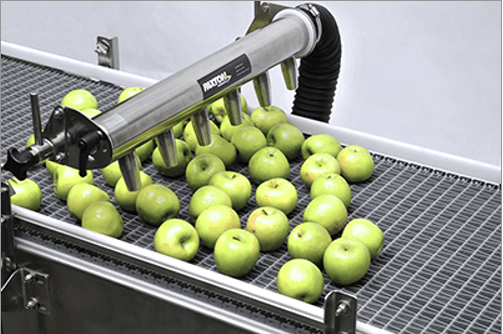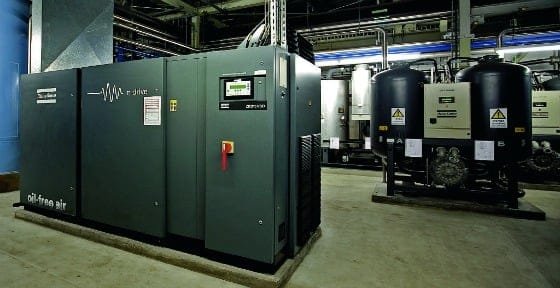[vc_row][vc_column][us_single_image image=”1527″ size=”tnail-masonry” align=”center”][/vc_column][/vc_row][vc_row][vc_column][vc_column_text]Your compressed air system is essential to powering your applications and processes – but did you know that its ability to perform effectively largely rests on the system’s air quality? Efficient production processes and uncontaminated end products rely on the purity of compressed air. What this means is simple: poor quality compressed air can result in extensive damage and lead to serious performance degradation. Even some of the most common air quality issues, including particulate contamination, wet/moist air, and oil in the air, can have a dramatic impact on your compressor system’s efficiency & productivity level.
Compressed air is a vital energy source and is utilized in multiple operations in a food processing facility and many industrial processes. When properly treated, compressed air is regarded as a safe, clean utility, as compared to other energy sources. Compressed air provides the energy source for pneumatic conveyors that transport liquids, powders and moisture sensitive product throughout the plant. Thus its quality is the most important thing to consider when dealing with it.[/vc_column_text][/vc_column][/vc_row][vc_row][vc_column][us_single_image image=”1530″ size=”tnail-masonry” align=”center”][/vc_column][/vc_row][vc_row][vc_column][vc_column_text]Standard:
The International Standards Organization (ISO) created ISO 8573-1 to provide manufacturers, with the ability to define the level of tolerance for air purity in their compressed air system. This standard outlines the levels of solid particulates, water, and oil allowed based on the classification. Compressed air quality class 0 is the highest purity of air. The most stringent class is air free of oil, aerosols and vapors. This is below 0,01 mg/m3 of these impurities. 0 also means minimizing the risk of air pollution.
ISO 8573-1:2010 is an international standard that:
- Categorizes air quality into different classes.
- Specifies maximum permissible Contamination levels for each class.
- Each class refers to certain Industrial applications.
Quality:
International Organization for Standardization (ISO) agree that the primary contaminants to monitor are particles, water, and oil (PWO). These Contaminants in Compressed Air:
- Oil
- Water
- Particles
Air Quality is the measure of presence of these contaminants in the compressed air.
Contaminants:
Oil:
Atmospheric air typically contains between 0.05 mg/m3 and 0.5mg/m3 of oil vapor. Common sources are vehicle or motor exhaust and industrial processes. Atmospheric air contains oil when it is drawn into the compressor, and if you’re using an oil-injected compressor, liquid oil and oil aerosols are introduced in the compression chamber for cooling and sealing purposes. But the oil can also make its way downstream into the larger compressed air system – which is a danger, depending on the air quality required by your application.
The quantity of oil in compressed air depends on several factors, including the type of machine, design, age and condition.[/vc_column_text][/vc_column][/vc_row][vc_row][vc_column][us_single_image image=”1532″ size=”medium” align=”center”][/vc_column][/vc_row][vc_row][vc_column][vc_column_text]Wet air:
Atmospheric air typically contains 1,000-50,000 ppm of water depending on where you live. If left untreated, compressed air with high levels of water is unacceptable for critical applications. When air becomes heated during the compression process, the water particles will condense. Depending on inlet conditions, air compressors can produce lots of water. If this water is not removed, it can travel through your piping and overwhelm your air dryer (if you have one). Plus, it can negatively impact your applications down the line.
A characteristic of compressed air is that it can’t contain the same amount of water vapor as the ambient air if it is compressed to a smaller volume and cooled. The water is squeezed out of the air just like squeezing a sponge. On a warm humid summer day, say 80° F, a fully loaded 75-hp compressor will produce about 23 gal of condensed water in an 8-hour shift. Another 4 gal will come out of the air dryer.
Problems caused by water vapors:
Water vapor included in the compressed air and can potentially cause problems. Examples include: high maintenance costs, shortened service life and impaired tool performance, high rate of rejection with spray painting and plastic injection, increased leakage, disturbances in the control system and instruments, shorter service life for the pipe system due to corrosion and more expensive installation.[/vc_column_text][/vc_column][/vc_row][vc_row][vc_column][us_single_image image=”1535″ size=”medium” align=”center”][/vc_column][/vc_row][vc_row][vc_column][vc_column_text]Particulates:
Atmospheric air contains natural contaminants, including dirt, dust, and other small particles – all of which enter the system when the air is sucked into the compressor. Air pollution is not only a public health and environmental problem. It also contributes contamination in the form of millions of particles per cubic meter. These particles consist of acids (nitrates and sulfates), organic chemicals, metals, and soil or dust particles. Coarse particles are between 2.5 microns and 10 microns in diameter. The finer particles with a diameter of 2.5 microns or smaller are not removed by the intake filter and enter into the compressed air system.
The compressor can contribute wear particles from its operation. Wear particles can be metallic or polymeric. Particles can also be generated from a compressed air system that utilizes a refrigerated dryer and iron piping or iron receivers. The combination of water and iron will form rust and pipe scale. Viable particles (micro-organisms) can also grow in this warm, dark, nutrient rich environment.
If you want more information regarding air quality or need a practical hand on experience. Please visit.
Reference: https://www.ifsqn.com/articles.html/_/articles/the-major-contaminants-in-compressed-air-r52; https://rastgar-co.com/air-quality/; https://www.thecompressedairblog.com/challenger/quality[/vc_column_text][/vc_column][/vc_row]






